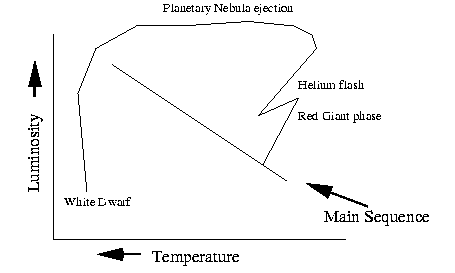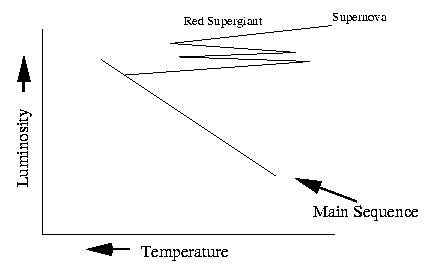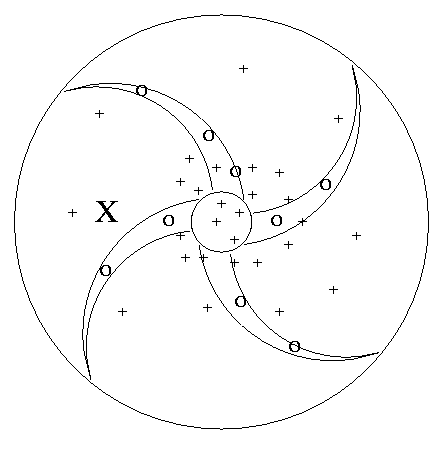
Second Hour Exam |
1998 April 15 |
1) How many neutrons are in one nucleus of 83Bi209?
Answer: d) 126
The superscript tells you that Bismuth has 209 nucleons, and the subscript tells you that 83 of them are protons. The remainder must be neutrons, and 209 - 83 = 126.
2) One of the primary differences between elliptical and spiral galaxies is that
Answer: c) elliptical galaxies don't have as much dust as spirals.
The distinguishing characteristic that sets ellipticals apart from spirals (other than their obvious morphology differences) is the lack of dust in ellipticals means that very few stars are currently forming. As for the other answers, a) and b) are not true, and while some ellipticals are very big, it's not true that all ellipticals are larger than spirals, so d) is out. Answer e) is probably also not true, though we really can't say for sure.
3) The astronomer who determined that the Sun is not at the center of the Milky Way galaxy was
Answer: e) Harlow Shapley.
It was Shapley's study of the distribution of globular clusters in the sky the indicated our Sun was not at the center of our galaxy.
4) When we look up into the night sky and see that faint circular band of light we call the Milky Way, we can tell, just as Johann Lambert and Thomas Wright could, that
Answer: a) we live inside a disk-shaped galaxy.
All of the other answers are true statements, but only the first statement can be concluded simply from a visual examination of the sky.
5) Why can we see the center of our galaxy in infrared light, but not in visible light?
Answer: c) Because infrared photons have a longer wavelength than visible light, infrared light can travel through the obscuring dust between here and the galactic center.
Longer wavelength light does a better job penetrating through clouds and dust. That's why planes use radar to navigate on dark and stormy nights.
6) When photons are emitted from a region of strong gravity such as the surface of a neutron star, their wavelengths change as they move outward because of
Answer: d) the gravitational redshift.
Because it takes energy to move out of a strong gravitational field, photons lose energy as they move away form neutron stars, black holes, or any source of gravity. Since a photon is nothing but energy, when it loses some of its energy, its wavelength increases (remember E = hc/lambda). Hence the term "red-shift". (Note that this type of redshift is different from a Doppler shift, which is induced by the relative motion of the emitter and observer.)
7) In the H-R Diagram below, draw the path a low mass star takes after it leaves the Main Sequence. Label your path with the various phases the star goes through (e.g., red giant, helium flash, planetary nebula ejection, supernova, white dwarf) as appropriate.
Answer:

8) In the H-R Diagram below, draw the path a high mass star takes after it leaves the Main Sequence. Label your path with the various phases the star goes through (e.g., red giant, helium flash, planetary nebula ejection, supernova, white dwarf) as appropriate.
Answer:

9) Plotted as x's on the H-R Diagram below are the surface temperatures and luminosities of all of the stars in a galactic open cluster, along with a line indicating the position of the Main Sequence. Look at the diagram, and with the help of the data in the table below it, estimate the age of the cluster.
Answer: 1-5 billion years
The spectral type of the "turn-off" stars is the key to this problem. These are the stars that are just leaving the Main Sequence, and so they must have just finished their Main Sequence lives. More massive stars which used to be on the higher part of the Main Sequence, have already run out of hydrogen in their cores and so have evolved off the Main Sequence to become giants. Stars of lower mass still have plenty of hydrogen left (mainly because they fuse it so slowly), and so will happily remain on the Main Sequence for many years to come. The turn-off appears to be at an effective surface temperature of about 8000 K, which means that stars of spectral type A and F are just running out of hydrogen in their cores. How long does it take an A or F star to exhaust the hydrogen in its core? About 1-5 billion years.
10) Below is a diagram showing a face-on view of the disk of the Milky Way galaxy. The center of the galaxy is indicated by the circle in the center , and four spiral arms extend outward from it. On this diagram,
Answer:

To get credit, the Sun's position had to be more than halfway from the center of the galaxy, O stars had to be located along the spiral arms, and the distribution of globular clusters had to be centrally condensed around the center of the galaxy, and bear no relation to the spiral arm structure.